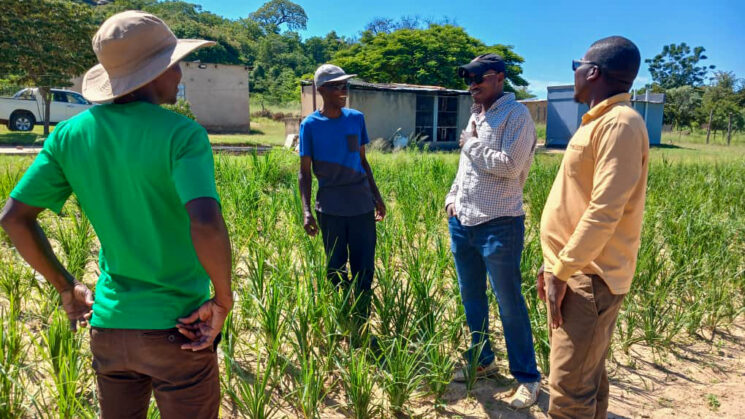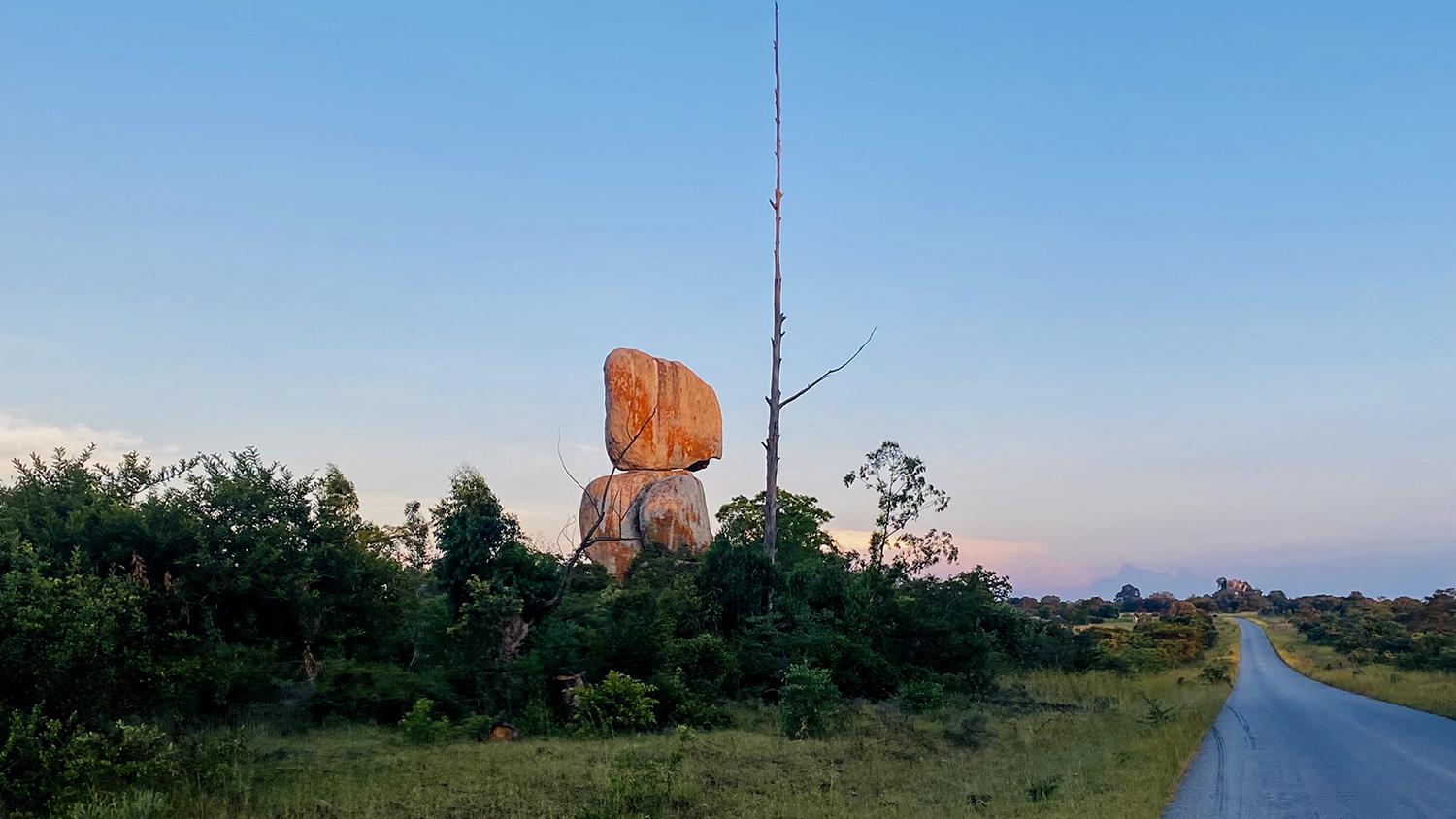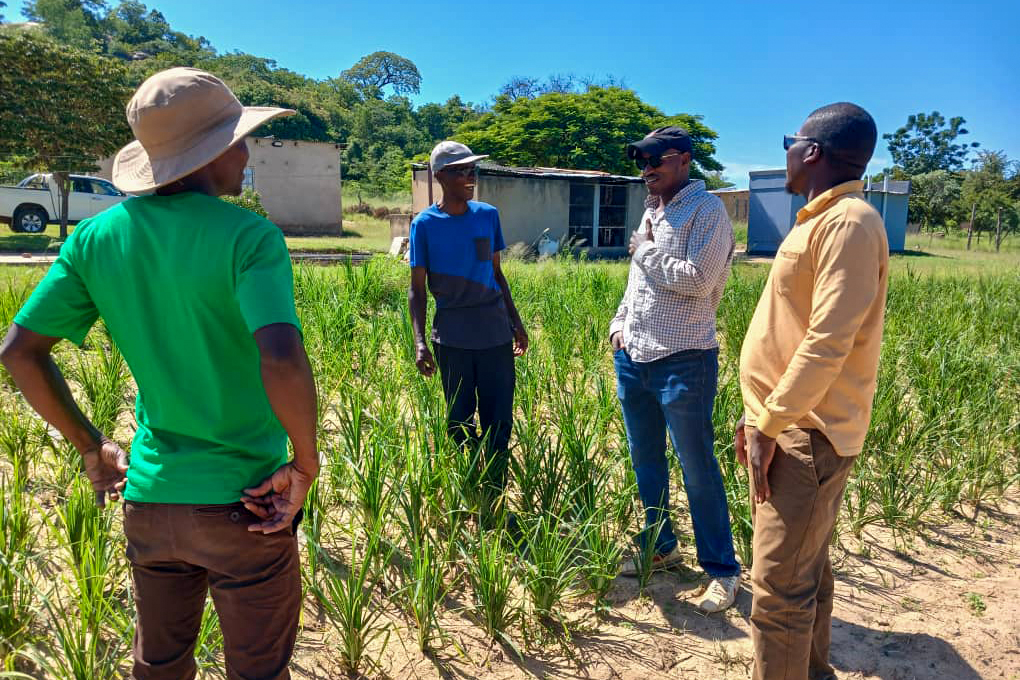
Embarking on a three-month journey with CIMMYT in Zimbabwe, I delved into the heart of smallholder agriculture, witnessing firsthand the challenges, innovations, and unwavering resilience of farmers, offering a glimpse into their lives and the quest for food security in a changing climate.
Written by: Eric Butoto

Balancing rocks along the Chivhu Gutu Road to Bikita district.
*Note: The opinions expressed in this article are those of the authors as individuals and should not be taken as a reflection of the views of the whole of the Genetic Engineering and Society Center or NC State University.
In December 2023, I embarked on a three-month visit to the International Maize and Wheat Improvement Center (CIMMYT) in Harare, Zimbabwe. CIMMYT is an international non-profit research organization that works to develop improved maize and wheat varieties and other agriculture innovations for smallholder farmers in low and middle-income countries. Two opportunities inspired me to undertake this trip. First, to collaborate with researchers at CIMMYT on a project that examines the performance of drought-tolerant maize under smallholder farmers’ management practices, particularly in El Niño year. Second, I wanted to personally experience and learn about the current state of agriculture in southern Africa.
I was based in the capital city of Harare and had opportunities to visit with more than ten smallholder farmers in the districts of Murehwa and Bikita, which are 55 and 240 miles from the capital city of Harare, respectively. Some of the farms were in very remote areas of these districts, which required long drives on dirt roads in the countryside. Unlike driving in the countryside of my home state of Iowa, where views are dominated mainly by maize and soybeans, Zimbabwe was fascinating because you never knew what you would come across, whether it was encountering baboons or breathtaking landscapes with balancing rocks.
This post and the time I spent listening to farmers and seeing various agriculture practices are insufficient to capture the complexity and lives of smallholder farmers in Zimbabwe. Still, I hope to give you a glimpse into their everyday lives.
Abiotic and biotic stressors determine smallholder farmers’ security
All the farms I visited were about five or fewer acres and produced maize along with various vegetables and livestock. At first sight, most farmers’ maize appeared to be drought-stressed with rolled leaves, browning at the tips, and uneven growth. The rain had been scarce since planting, and it had not rained in the last few weeks in Murehwa district. Even farmers with less drought stress indicated that their crops were at risk if it did not rain soon. These farmers rely on natural rainfall for irrigation and expressed concern about unpredictable rains due to the changing climate. Faced with this uncertainty, many farmers plant finger millet or pearl millet, which are more drought tolerant, as a backup crop in case maize fails.

Standing in a finger millet field for the first time as a farmer (blue/black shirt) along with a CIMMYT researcher and agriculture extension agent, explains its various uses in Murehwa district.
This year is an El Niño season, which brings high temperatures and low rainfall in southern Africa, threatening the security of millions of farmers. As I write this, the drought continues to ravage the region. Staple food prices will continue to rise in these regions, contributing to more food insecurity for millions of people. Recently, Zimbabwe, Zambia, and Malawi declared national disasters and emergencies, and humanitarian aid will likely be needed to feed people due to this drought.
On top of the drought, many farmers must also protect their crops from biotic stressors, mainly fall armyworm (Spodoptera frugiperda). First identified in 2016 in southern Africa, fall armyworm devastates maize by feeding on the leaf and ear, and if it is severe, it can cause more insecurity to an already vulnerable population. It can now be managed with proper monitoring and a timely insecticide spray. Unfortunately, not all farmers can regularly spray insecticide due to monetary constraints. As a result, some rely on luck to avoid being greatly infested by the fall armyworm.
CIMMYT, in collaboration with national partners, developed and released more tolerant elite maize hybrids, which provide a more economical solution. Another potential solution is genetically engineered (GE) maize with an insecticidal protein similar to Bacillus thuringiensis (Bt) for European corn borer. Appropriate Bt toxin and agronomic management practices would need to be explored for this region for this solution to be effective. Currently, GE maize is only grown in a few African countries (Zimbabwe is not one of them) and would need to overcome regulatory, political, and consumer acceptance.

Fall armyworm (Spodoptera frugiperda) larvae and damaged leaves in Murehwa district.
Resources or lack of them determine smallholder farmers’ security
The farmers I visited in Zimbabwe share struggles similar to those in North Carolina, such as labor shortages. This is something that I did not imagine encountering because there is more labor in the capital city in various industries. However, some farmers rely on extra labor to prepare the land and plant. In exchange for labor, workers either received cash or grain payment and in some cases, the farmer returned the favor to another farmer’s land. All the farmers I visited in the two districts did everything by hand (land preparation, planting, weeding, and harvest) with little to no mechanization.
Concerns about drought are at the forefront for all farmers. One that I spoke to in Murehwa said, “With no consistent rains in recent years, we are trying to save money to dig a borehole to get water,” as growing crops on this land is arduous. Another expressed his desire to drill a borehole but said he had no money to do so. With enough money, many farmers could drill boreholes, irrigate their farms, and significantly improve their security. However, smallholder farmers have limited monetary resources, and farming is not profitable at this scale.
As I talked to farmers in Murehwa, I wanted to know what could improve their security. While noting and fully realizing that more land does not necessarily equate to more yield and money without the proper agricultural practices and investments. I specifically asked if they were given more arable land would that change their security? One farmer said he was too old and wanted to grow enough food for his family. Some farmers said they would if they had the land but expressed concerns that the grain prices were unfavorable. They may or may not recuperate the cost of inputs, so it is not in their best interest to seek more land to farm unless the grain prices are favorable.
The adoption of agricultural innovation can change smallholder farmers’ security
Many smallholder farmers I visited adopt various agricultural innovations and practices, which is not the typical narrative of smallholder farmers in this part of the world. I asked many farmers how they decided which maize hybrid variety to grow. To my surprise, some farmers host demonstration plots for the local seed companies on their farms, allowing the community to see how various hybrids perform in their environments and management practices. Additionally, the farmers can shell and mill the various hybrids to make sadza (fufu or ugali in other parts of the continent), a staple maize meal in many African countries, and get a complete sensory evaluation. A woman farmer in Murehwa with one of the best maize fields said she grew this hybrid variety because it was the best yielder and tasted the best in her demonstration plots the previous season.
All farmers practiced some form of conservation agriculture, whether minimal soil tillage, intercropping, or mulching between maize rows for permanent soil cover. One of the best maize fields I saw was in Murehwa, where a male farmer had used all these conservation efforts and attested to an improvement in yield on his farm. When I grabbed the soil from his field, it was a mixture of dark soil with mulch and it held more moisture, which is essential as rainfall had been sparse this year. These types of practices help farmers be more resilient by potentially improving their yields and soil fertility.

A farmer in Murehwa district is showing me the improvement of his soil and maize due to conservation agriculture practices.
Two farmers I visited in Bikita had unique and innovative farming practices. One was an agronomist extension agent and the other had just started farming in the last couple of years. The new farmer was learning and adopting the practices of the agronomist. These two farmers dug large holes in their farms, placed plastic into them, and filled them with water and fish. They started raising fish and even breeding them as a way to diversify their farming operations. They also started planting banana trees on their farms, which I had not seen in my other farm visits. Maize production is a given to farmers in Zimbabwe as maize is a staple crop; however, diversifying their farms could bring in extra income that could improve the security of their families, especially as relying on farming is becoming riskier for smallholder farmers in this part of the world.

Farmer diversifying their farm by investing in a fish farming and banana plantation in Bikita district.
Concluding remarks
In Zimbabwe, I saw firsthand the challenges these farmers face with limited resources, their resilience, and their willingness to embrace various agricultural innovations. These observations give me hope for the future of food security on the continent, and these farmers have also renewed my desire to be part of that solution. To me, irrigation seems to be the biggest challenge, and improvements here could boost their security, especially with frequent severe droughts due to the changing climate. However, this will require financial and infrastructural resources from various groups, such as farmers, government, private entities, or outside donors working together to make this possible. Over the past few decades, a lot of progress and development has been achieved in African agriculture, however, a lot of work remains.
Eric Butoto is a Ph.D. student in the Department of Crop and Soil Sciences at North Carolina State University focusing on maize breeding and genetics and a fellow in the GES Center’s interdisciplinary AgBioFEWS program. He can be reached at ebutoto@ncsu.edu.